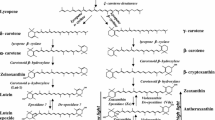Abstract
Wild-type Brassica oleracea L. have matte blue-green leaves caused by an interaction between leaf pigmentation and a waxy bloom coating the surface. Glossy mutants have reduced and/or altered epicuticular wax giving the leaves a shiny green appearance and have been identified in most B. oleracea crop varieties, including cauliflower, kale, broccoli, Brussels sprouts, cabbage, and collard. The genetic basis of glossy mutants has not been studied in B. oleracea. Glossiness can confer resistance to multiple herbivores mediated by modification of herbivore feeding behavior and foraging efficiency of their predators. The USDA-ARS-U.S. Vegetable Laboratory released two pairs of near-isogenic broccoli lines (NILs) that visibly differ only for glossiness, providing ideal germplasm for the genetic study of epicuticular wax in B. oleracea. Genotyping-by-sequencing resulted in hundreds of polymorphisms between each pair of NILs. Polymorphisms were identified in or near three different wax synthesis genes suggesting the two glossy mutants were caused by alteration of different steps of the pathway.


Similar content being viewed by others
References
Anstey TH, Moore JF (1954) Inheritance of glossy foliage and cream petals in Green Sprouting broccoli. J Heredity 45:39–41
Bradbury PJ, Zhang Z, Kroon DE et al (2007) TASSEL: software for association mapping of complex traits in diverse samples. Bioinformatics 23:2633–2635
Chatterton N, Hannah W, Powell J, Lee D (1975) Photosynthesis and transpiration of bloom and bloomless sorghum. Can J Plant Sci 55(2):641–643
Eigenbrode SD, Kabalo NN (1999) Effects of Brassica oleracea waxblooms on predation and attachment by Hippodamia convergens. Entomol Exp Appl 91:125–130
Eigenbrode SD, Stoner KA, Shelton AM, Kain WC (1991) Characteristics of leaf waxes of Brassica oleracea associated with resistance to diamondback moth. J Econ Entomol 83:1609–1618
Elshire RJ, Glaubitz JC, Sun Q et al (2011) A robust, simple genotyping-by-sequencing (GBS) approach for high diversity species. PLoS ONE 6:e19379
Farnham M (2010) Glossy and nonglossy near-isogenic lines USVL115-GL, USVL115-NG, USVL188-GL, and USVL188-NG of broccoli. HortScience 45:660–662
Farnham MW, Elsey KD (1995) Recognition of Brassica oleracea L. resistance against the silverleaf whitefly. HortScience 30:343–347
Gentry GL, Barbosa P (2006) Effects of leaf epicuticular wax on the movement, foraging behavior, and attack efficacy of Diaeretiella rapae. Entomol Exp Appl 121:115–122
Glaubitz JC, Casstevens TM, Lu F et al (2014) TASSEL-GBS: a high capacity genotyping by sequencing analysis pipeline. PLoS ONE 9:e90346
Hall DM, Matus AI, Lamberton J, Barber HN (1965) Infra-specific variation in wax on leaf surfaces. Aust J Biol Sci 18:323–332
Hariprasad KV, van Emden HF (2010) Mechanisms of partial plant resistance to diamondback moth (Plutella xylostella) in Brassicas. Int J Pest Manag 56:15–22
Jenks MA, Joly RJ, Peters PJ et al (1994) Chemically induced cuticle mutation affecting epidermal conductance to water vapor and disease susceptibility in Sorghum bicolor (L.) Moench. Plant Physiol 105:1239–1245
Jenks MA, Tuttle HA, Eigenbrode SD, Feldmann KA (1995) Leaf epicuticular waxes of the eceriferum mutants in Arabidopsis. Plant Physiol 108:369–377
Jenks MA, Rashotte AM, Tuttle HA, Feldmann KA (1996) Mutants in Arabidopsis thaliana altered in epicuticular wax and leaf morphology. Plant Physiol 110:377–385
Jordan WR, Shouse PJ, Blum A, Miller FR, Monk RL (1984) Environmental physiology of sorghum. II. Epicuticular wax load and cuticular transpiration. Crop Sci 24:1168–1173
Joubès J, Raffaele S, Bourdenx B et al (2008) The VLCFA elongase gene family in Arabidopsis thaliana: phylogenetic analysis, 3D modelling and expression profiling. Plant Mol Biol 67:547–566
Li H, Durbin R (2009) Fast and accurate short read alignment with Burrows-Wheeler Transform. Bioinformatics 25:1754–1760
Li H, Durbin R (2010) Fast and accurate long-read alignment with Burrows-Wheeler Transform. Bioinformatics 26(5):589–595
Li F, Wu X, Lam P et al (2008) Identification of the wax ester synthase/acyl-coenzyme A: diacylglycerol acyltransferase WSD1 required for stem wax ester biosynthesis in Arabidopsis. Plant Physiol 148:97–107
Macey MJK (1974) Wax synthesis in Brassica oleracea as modified by trichloroacetic acid and glossy mutations. Phytochemistry 13:1353–1358
Macey MJK, Barber HN (1970) Chemical genetics of wax formation on leaves of Brassica oleracea. Phytochemistry 9:13–23
McNevin JP, Woodward W, Hannoufa A, Feldmann KA, Lemieux B (1993) Isolation and characterization of eceriferum (cer) mutants induced by T-DNA insertions in Arabidopsis thaliana. Genome 36:610–618
Millar AA, Kunst L (1997) Very-long-chain fatty acid biosynthesis is controlled through the expression and specificity of the condensing enzyme. Plant J 12:121–131
North C, Priestley WG (1962) A glossy-leaved mutant of Brussels Sprout. HortResearch 1:95–99
Parkin IAP, Koh C, Tang H et al (2014) Transcriptome and methylome profiling reveals relics of genome dominance in the mesopolyploid Brassica oleracea. Genome Biol 15:R77
Rowland O, Zheng H, Hepworth SR et al (2006) CER4 encodes an alcohol-forming fatty acyl-coenzyme A reductase involved in cuticular wax production in Arabidopsis. Plant Physiol 142:866–877
Stoner KA (1990) Glossy leaf wax and plant resistance to insects in Brassica oleracea under natural infestation. Environ Entomol 19:730–739
Stoner KA (1992) Density of imported cabbageworms (Lepidoptera: Pieridae), cabbage aphids (Homoptera: Aphididae), and flea beetles (Coleoptera: Chrysomelidae) on glossy and trichome-bearing lines of Brassica oleracea. J Econ Entomol 85:1023–1030
Swarts K, Li H, Romero Navarro JA, et al (2014) Novel methods to optimize genotypic imputation for low-coverage, next-generation sequence data in crop plants. The Plant Genome 7:0
Thompson KF (1963) Resistance to the cabbage aphid (Brevicoryne brassicae) in Brassica plants. Nature 198:209
Ulmer B, Gillott C, Woods D, Erlandson M (2002) Diamondback moth, Plutella xylostella (L.), feeding and oviposition preferences on glossy and waxy Brassica rapa (L.) lines. Crop Prot 21:327–331
Wang M, Farnham M, Nannes J (1999) Ploidy of broccoli regenerated from microspore culture versus anther culture. Plant Breed 118:249–252
Acknowledgements
This study was funded by the United States Department of Agriculture, CRIS Project No. 6080-21000-018-00D.
Author information
Authors and Affiliations
Corresponding author
Electronic supplementary material
Below is the link to the electronic supplementary material.
Rights and permissions
About this article
Cite this article
Branham, S.E., Farnham, M.W. Genotyping-by-sequencing of waxy and glossy near-isogenic broccoli lines. Euphytica 213, 84 (2017). https://doi.org/10.1007/s10681-017-1873-9
Received:
Accepted:
Published:
DOI: https://doi.org/10.1007/s10681-017-1873-9




